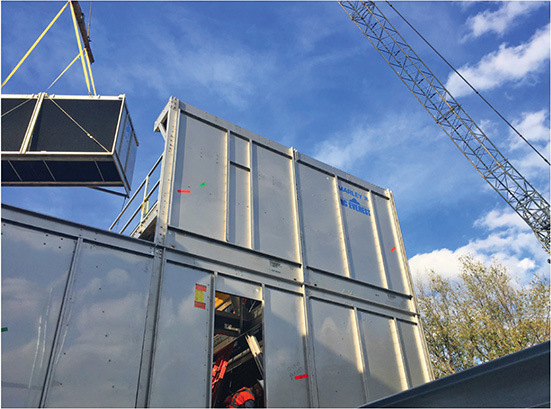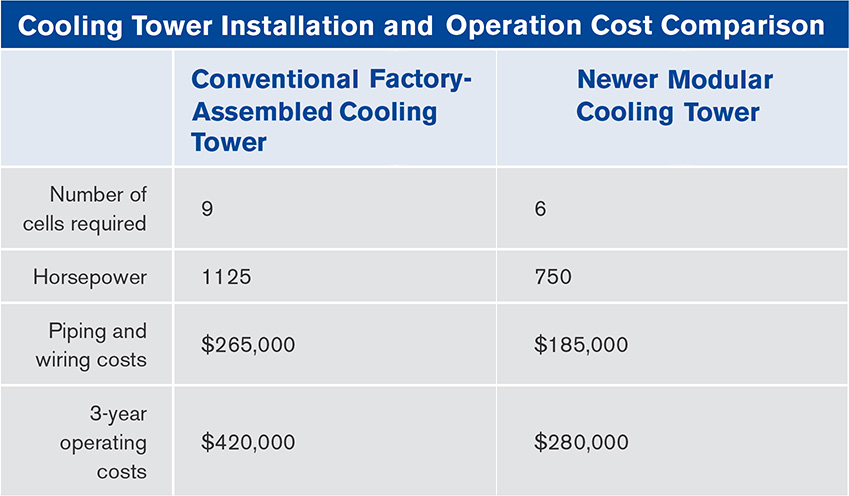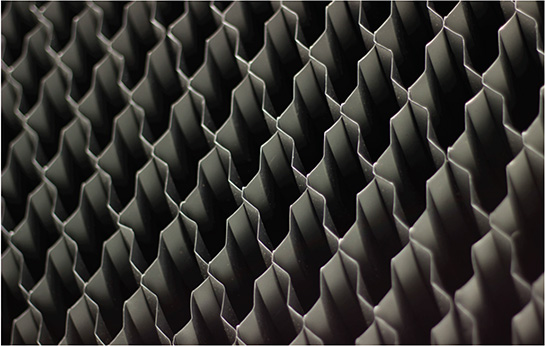
Die nächste Generation werkseitig montierter Kühltürme kann bis zu 60 Prozent schneller geliefert werden als vor Ort errichtete Türme und 80 Prozent schneller installiert werden.
Aktuelle Entwicklungen in der werkseitig montierten Kühlturmtechnologie führen zu einer zunehmenden Anwendung sogenannter „Paket“-Türme zur Unterstützung von HLK- und Industrieprozessen. Obwohl für Kraftwerke und Industrieprozesse vor Ort montierte Türme bevorzugt wurden, eignen sich heute gut konzipierte modulare Produkte für ein breiteres Anwendungsspektrum, um Prozesse zu vereinfachen und das Endergebnis positiv zu beeinflussen.
So kann beispielsweise ein werkseitig montierter Kühlturm mit modernem Design mit 60 Prozent kürzerer Vorlaufzeit geliefert und bis zu 80 Prozent schneller installiert werden als dies für den Bau eines herkömmlichen, vor Ort errichteten Kühlturms normalerweise geschätzt wird. Da kein kostspieliger Betonbeckenbau erforderlich ist, die Rohrleitungen und die elektrische Verkabelung vereinfacht werden und die Aufstellung vor Ort flexibel ist, ziehen Industrieverarbeiter die Kostenvorteile moderner, werkseitig montierter Türme häufiger in Betracht.

Mit drei Zellen weniger benötigt der neuere Turm nur 750 PS, um die gleichen Anforderungen zu erfüllen, und die Kunden erzielen erhebliche Kosteneinsparungen.
Reduzierung der Energie- und Installationskosten für HLK-Anlagen
Für HVAC-Endnutzer, die zunehmend Wert auf die Reduzierung des Energieverbrauchs legen, sind die neuen Kühlturmdesigns von heute speziell auf Energieeffizienz ausgerichtet. Durch die Verwendung größerer Gehäusegrößen und Motoren mit geringerer Leistung können moderne, werkseitig montierte Querstromtürme diese Anforderungen erfüllen und bis zu 50 Prozent mehr Kühlleistung pro Zelle bieten und bis zu 35 Prozent weniger Lüfterleistung pro Tonne Kühlung verbrauchen.*
Neben den geringeren Energiekosten können diese neueren Designs auch die Installationskosten für HLK-Systeme erheblich senken. Die erhöhte Kühlleistung pro Zelle bedeutet, dass die Kunden weniger Zellen, weniger Rohrleitungen und weniger elektrische Anschlüsse benötigen, was den Arbeits- und Materialbedarf minimiert. Sicherheitsrisiken, die mit einer langen und komplizierten Installation verbunden sind, werden minimiert.

Der Bau eines vor Ort errichteten Turms ist ein komplexer Prozess, der 20 Wochen oder länger dauern kann.
Reduzierung der Montagekosten vor Ort für die Prozesskühlung
Der Bau von Kühltürmen sowie das Kosten- und Zeitmanagement sind nach wie vor die Hauptsorgen derjenigen, die große Prozesskühlungsprojekte überwachen. Es kann 20 Wochen oder länger dauern, bis die Komponenten eines typischen vor Ort errichteten Projekts vor Ort eintreffen, was große Arbeitskräfte und ausgedehnte Bereitstellungsflächen erfordert. Die Baukosten können schnell in die Höhe schnellen und die Schätzungen übersteigen, und die Auftragnehmer rechnen oft mit Verzögerungen. Je länger sich ein Installationsprojekt hinzieht, desto wahrscheinlicher ist es, dass Wetterprobleme die Fertigstellung beeinträchtigen. Komplexe Industrieprojekte erhöhen auch die Sicherheitsbedenken vor Ort.
Industrielle Verarbeiter, die nach alternativen Lösungen suchen, greifen auf vormontierte Kühlturmmodule zurück, die in einer kontrollierten Fabrikumgebung gebaut und in sechs bis acht Wochen an den Standort geliefert werden. Der Installationsprozess wird sorgfältig inszeniert und verwaltet, wodurch im Vergleich zu vor Ort errichteten Projekten bis zu 80 Prozent Zeit gespart werden kann. Die kürzeren Liefer- und Bauzeiten vormontierter Türme bieten Kunden aus der industriellen Verarbeitung einen deutlichen Vorteil, da die Erfüllung von Kapazitätsanforderungen und die Bewältigung von Ausfallzeiten und Ausfällen für ihren Betrieb von entscheidender Bedeutung sind. Darüber hinaus reduzieren ihr modulares Design und der Montageprozess vor Ort den Arbeitsaufwand vor Ort, die Arbeitsdauer und den Platzbedarf, was zu einer potenziell sichereren Arbeitsumgebung beiträgt.
Ein Kunde, der die Vor- und Nachteile einer vor Ort errichteten Anlage gegenüber einer werkseitig montierten Anlage abwägte, erhielt kürzlich einen Kostenvoranschlag für den Austausch eines vor Ort errichteten Kühlturms, der 4.500 Arbeitsstunden und sieben Wochen vor Ort erforderte. Als ein modularer, vormontierter Turm gewählt wurde, konnte das Bauteam die Installationszeit auf weniger als zwei Wochen verkürzen – eine enorme Zeitersparnis und Steigerung der Betriebseffizienz der Anlage. Der modulare Turm eliminierte außerdem die zusätzlichen Kosten der Anlage für eine temporäre Kühlung während des Bauprozesses.
Für den Bau eines vor Ort errichteten Kühlturms ist die Errichtung eines Fundaments in Form eines Kaltwasserbeckens aus Beton erforderlich. Allein die Kosten für dieses Becken erhöhen die Baukosten des Turms normalerweise um 40 Prozent. Ein werkseitig montierter Turm verfügt jedoch über ein integriertes Becken und eliminiert die zusätzlichen Baukosten bei vor Ort errichteten Projekten. Die gängige Praxis besteht darin, diese integrierten Becken im Werk zusammenzubauen und auf Dichtheit zu prüfen. Vor Ort errichtete Türme müssen häufig vor Ort getestet werden, um sicherzustellen, dass sie die angegebene Kühlleistung erfüllen. Die von unabhängigen Drittagenturen durchgeführten Tests kosten normalerweise etwa $25.000. Bei werkseitig montierten Türmen entfallen diese zusätzlichen Kosten, da sie vom Cooling Technology Institute zertifiziert sind und die angegebene Wärmeleistung erfüllen.

Die modernen Tropfenabscheider-Designs von heute können die niedrigste verfügbare Driftrate von bis zu 0,00051 TP3T des zirkulierenden Wasserdurchflusses erreichen, sodass weniger Wasser aus dem Turm entweicht.*
Konstruktive Vorteile neuer, vormontierter Kühltürme
Kühltürme mit fortschrittlichem, modularem Design werden häufig aus schwerem, verzinktem Stahl oder rostfreiem Stahl hergestellt und sind so konstruiert, dass sie den Anforderungen von HVAC- und Schwerindustrieanwendungen standhalten. Wenn diese Türme mit der neuesten Technologie zur Abdriftbeseitigung ausgestattet sind, können sie die niedrigste verfügbare Abdriftrate erreichen, bis zu 0,0005% des zirkulierenden Wasserdurchflusses, sodass weniger Wasser aus dem Turm entweicht.* Darüber hinaus hat der breitere Markt mehr Funktionen für mehr Komfort und einfache Wartung gefordert. Die neuesten Designs machen Inspektionen und Wartung sicherer und einfacher. Einige der heutigen Türme verfügen sogar über bis zu sieben Fuß hohe Zugangstüren und einen weitläufigen Innenraum mit Servicedecks.
Kühltürme sind in der Regel so ausgelegt, dass sie den Kühlbedarf im Sommer decken. Die Querstromkonstruktion moderner, werkseitig montierter Kühltürme ermöglicht jedoch einen Betrieb mit „variablem Durchfluss“, wodurch die Wasserdurchflussrate und der Energieverbrauch in den kühleren Monaten reduziert werden. Dadurch wird sichergestellt, dass nur dann Energie für die Kühlung verbraucht wird, wenn die Anlage sie wirklich benötigt, was die Effizienz maximiert. Im Gegensatz dazu lässt die Gegenstromkonstruktion vieler vor Ort errichteter Türme von Natur aus keine Änderungen der Durchflussrate zu und verbraucht das ganze Jahr über unabhängig vom Bedarf die gleiche Energiemenge.
Querstromkonstruktionen schützen Kaltwasserbecken außerdem vor Sonneneinstrahlung und verhindern so Algenwachstum, das die Leistung des Turms beeinträchtigen und häufigere Wartung erforderlich machen kann. Darüber hinaus verhindert eine Querstromkonstruktion bei kaltem Wetter, dass bei starkem Wind Wasser austritt, was zu Vereisung und Sicherheitsbedenken führen kann.
Ob Sie nun ein hochmodernes Kühlsystem entwerfen oder einen herkömmlichen Kühlturm ersetzen, berücksichtigen Sie sorgfältig die neueste Technologie und die besten Optionen für Ihre Anwendung. Werkseitig montierte Crossflow-Kühlturmkonstruktionen werden immer häufiger als effizientere und kostengünstigere Wahl angesehen, insbesondere als Alternative zu teureren und zeitintensiveren Bauprojekten vor Ort für eine Reihe von HVAC-, Prozesskühlungs- und Schwerindustriekühlungsanwendungen.
*Im Vergleich zu anderen fabrikmontierten Einzelzellen-Querstromkühltürmen.

